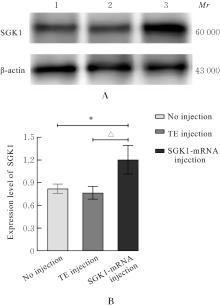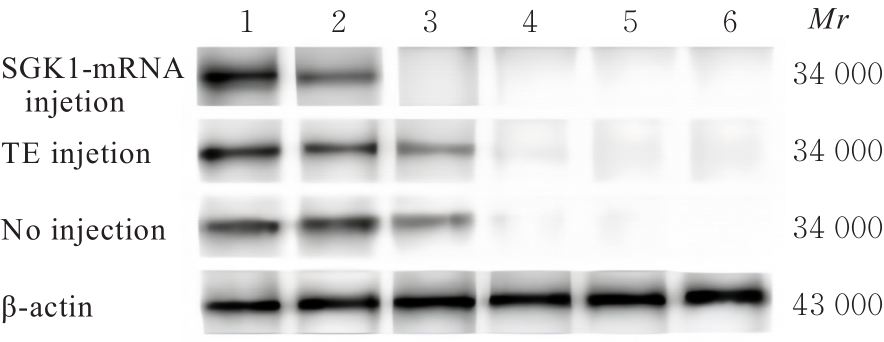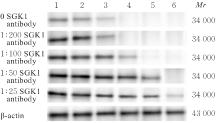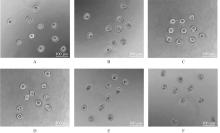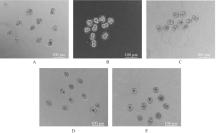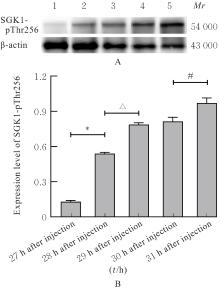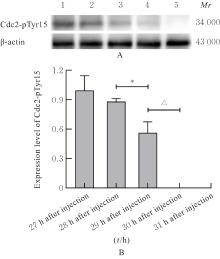吉林大学学报(医学版) ›› 2024, Vol. 50 ›› Issue (3): 628-637.doi: 10.13481/j.1671-587X.20240306
• 基础研究 • 上一篇
SGK1对Cyclin B/Cdc2通路介导小鼠G1期受精卵卵裂的调控作用及其机制
- 内蒙古医科大学附属医院检验科,内蒙古 呼和浩特 010050
Regulatory effect of SGK1 on oocyte cleavage in fertilized eggs in mice at G1 stage mediated by Cyclin B/Cdc2 pathway and its mechanism
Huiling ZHANG,Di HAN,Wengxiu GUO,Haiyao PANG,Jun MENG( )
)
- Department of Laboratory,Affiliated Hospital,Inner Mongolia Medical University,Hohhot 010050,China
摘要:
目的 探讨血清和糖皮质激素诱导蛋白激酶1(SGK1)在小鼠细胞周期G1期受精卵早期发育过程中的调控作用,并阐明相关机制。 方法 取若干只4~6周龄且体质量约为20 g的雌鼠和若干只8周龄以上且体质量约为30 g的雄鼠,雌鼠腹腔注射孕马血清促性腺激素(PMSG),每只10 IU,48 h后腹腔注射人绒毛膜促性腺激素(HCG),每只10 IU,并将注射HCG的雌鼠与雄鼠1∶1合笼过夜。取交配成功的雌鼠受精卵,注射HCG后分别于12~21 h、21~26 h、26~28 h和28~30 h收集细胞周期G1期、S期、G2期及M期的受精卵,并于光学显微镜下观察不同细胞周期的细胞形态表现。收集小鼠超排卵后 G1 期受精卵,体外转录生成 mRNA 后,分为未注射组、Tris-EDTA缓冲液注射组(TE注射组)和SGK1-mRNA注射组。采用SGK1抗体与KSOM培养液配置1∶25、1∶50、1∶100、1∶200和0共5种不同浓度SGK1抗体组的培养液,培养小鼠G1期受精卵。Western blotting法检测各组小鼠受精卵中SGK1蛋白表达水平和各组小鼠及不同浓度SGK1抗体组HCG注射不同时间受精卵中磷酸化细胞分裂周期因子2(Cdc2)酪氨酸15位点(Cdc2-pTyr15)去磷酸化情况,相差显微镜观察各组小鼠和不同浓度SGK1抗体组受精卵发育情况,Western blotting法检测HCG注射不同时间小鼠受精卵中磷酸化SGK1-苏氨酸256位点(SGK1-pThr256)和Cdc2-pTyr15蛋白表达水平。 结果 与未注射组和TE注射组比较,SGK1-mRNA注射组SGK1蛋白表达水平明显升高(P<0.01)。HCG注射后27~28 h,SGK1-mRNA注射组小鼠受精卵中Cdc2-pTyr15磷酸化信号逐渐消失,至HCG注射29 h,Cdc2-pTyr15磷酸化信号完全消失;HCG注射后28~29 h,未注射组和TE注射组小鼠受精卵中Cdc2-pTyr15磷酸化信号逐渐消失,至HCG注射后30 h,Cdc2-pTyr15磷酸化信号完全消失;随着SGK1抗体浓度升高,不同浓度SGK1抗体组受精卵中Cdc2-pTyr15磷酸化信号减弱和磷酸化信号消失的时间逐渐延长。HCG注射后27 h,SGK1-mRNA注射组小鼠受精卵开始卵裂;HCG注射后31 h,SGK1-mRNA注射组受精卵几乎全部分裂为G2期细胞受精卵;HCG注射后33 h,0 和 1∶200 SGK1 抗体组受精卵全部发生卵裂;随着 SGK1 抗体浓度升高, 1∶25、1∶50 和1∶100 SGK1抗体组受精卵卵裂逐渐减少,在1∶25 SGK1抗体组受精卵卵裂减少最明显。HCG注射后31 h,与未注射组和TE注射组比较,SGK1-mRNA注射组小鼠受精卵死亡率明显降低(P<0.05),卵裂率明显升高(P<0.05)。注射HCG后31和33 h,随着SGK1抗体浓度升高,与1∶200 SGK1抗体组比较,1∶100、1∶50和1∶25 SGK1抗体组受精卵死亡率逐渐升高(P<0.05),卵裂时间延长,受精卵卵裂率降低(P<0.05),并呈剂量依赖性,其中1∶25 SGK1抗体组受精卵卵裂率最低。HCG注射后27 h,小鼠受精卵中SGK1-pThr256蛋白表达水平逐渐升高(P<0.05或P<0.01),并呈时间依赖性;HCG注射后28~29 h,小鼠受精卵中Cdc2-pTyr15蛋白表达水平逐渐降低(P<0.01),并呈时间依赖性,并于HCG注射后30 h完全消失。 结论 过表达或抑制SGK1均会影响小鼠G1期受精卵进入M期的时间,SGK1蛋白可能是小鼠G1期受精卵早期发育的调控因子之一,其可能通过Cdc2调节G1期受精卵发育。
中图分类号:
- Q132
